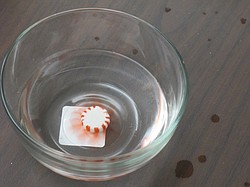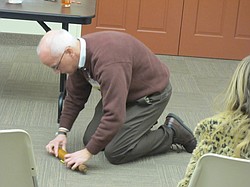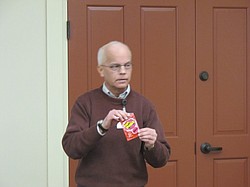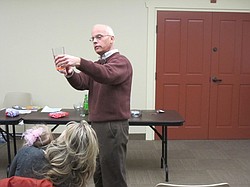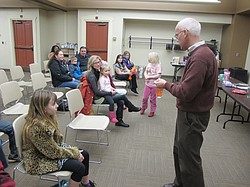Science plus candy equals fun at the library
Neighbors | Tim Cleveland.After being dropped into a bowl of water, a mint begins to melt.
Neighbors | Tim Cleveland.John Yingling flattens a Starburst candy with a rolling pin in a science experiment at Boardman Library.
Neighbors | Tim Cleveland.John Yingling displays a package of Pop Rocks before dropping them into a glass of water in a science experiment at Boardman Library.
Neighbors | Tim Cleveland.After dropping a package of Pop Rocks in water, John Yingling talked about how they fizz.
Neighbors | Tim Cleveland.Mackenzie Wigley (left) listened as John Yingling talked about the effects water has on Pop Rocks.
By TIM CLEVELAND
For most children, learning about science in school can be a chore and a bore, something to be tolerated until it’s time for more fun classes.
For John Yingling, a juvenile librarian at Boardman Library, he stumbled upon a book that gave him an idea to teach science in another way.
“I love science and I want to make science fun because it can be kind of boring,” he said. “I just happened to find this book [Candy Experiments] that came in [to the library] about candy science experiments. I was looking through it and I thought, wow there’s a lot of neat stuff in here. You can use things you have around the home - candy, water, baking soda. So I decided, let’s try a program.
“I’ve done science experiment programs in the past, and I really enjoyed putting them together. I just want to make it fun. I want to show the kids that things can be fun but you can learn something at the same time.”
Since then, Yingling said he has done [six or seven] demonstrations of using ordinary candy or other household items and mixing them with water, Sierra Mist or Sprite to demonstrate science.
Feb. 12 was the most recent demonstration he has done at the Boardman Library.
Before the event, Yingling said he was hoping for eight to 10 people to turn out, but a gathering of 13 children came to partake in the event.
Yingling started off by dropping a mint into a bowl of water. Within minutes, the mint began to melt, with its red lines merging into the water. Next, he putting a Starburst candy into another bowl of water, with it dropping to the bottom.
He then used a rolling pin to flatten out a Starburst candy on the floor. After molding the candy into a cup-like shape, he put it into the same bowl of water, with it this time floating on the surface.
One interested spectator was Mackenzie Wigley, a third-grader at Robinwood Lane Elementary.
“I used to do it [science experiments] at home, so I guess it kind of relates,” she said.
Yingling added that the main goal he has in doing the experiments is fun.
“It’ll spark their interest, I think,” he said. “A lot of times when you see the word science in school, you think, do I have to go to science class? It’s going to be teaching right out of a textbook. It’s all these formulas that nobody understands and these processes that nobody understands. If you see something like this where it’s almost hands on, I think it sticks in your mind more and the kids have more fun. It comes back to the fun because learning can be fun and not boring. It’s like giving the kids the idea that learning can be a lot of fun too.”
 43
43

